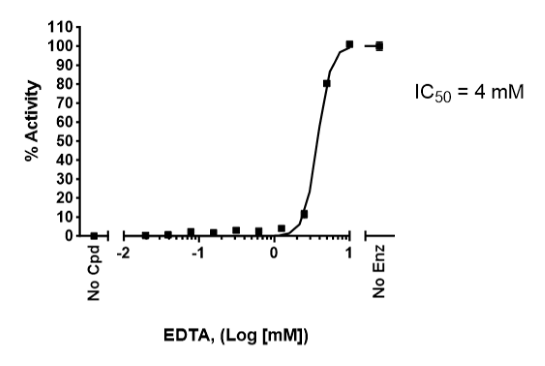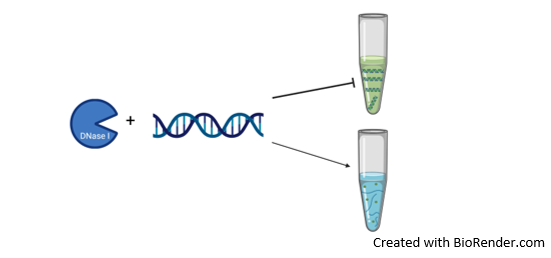

Applications
Study enzyme kinetics and screen small molecule inhibitors and high throughput screening (HTS) applications.
Shipment
-80°C (dry ice)
Literature References
Lazarus R. and Wagener J., 2019, Pharmaceutical Biotechnology: 471-488.
Description
The 2-Step DNase I Assay Kit is a homogeneous fluorescent based assay kit designed to measure DNase I activity for screening and profiling applications. The assay kit comes in a convenient 96-well format, with enough purified recombinant DNase I, DNA substrate, GroovyGreen™ dye, assay buffer and co-factors for 100 enzyme reactions. The kit also contains EDTA as internal control.
 Figure 1: 2-Step DNase I Assay Kit mechanism.
Figure 1: 2-Step DNase I Assay Kit mechanism.
DNase I cleaves DNA molecules into nucleotides. The amount of nucleotide formed correlates directly with DNase I activity and can be quantified by the addition of a fluorescent dsDNA-binding dye which distinguishes dsDNA from free nucleotides. Since the dye emits fluorescence only when bound to the target dsDNA, the signal is inversely proportional to DNase I activity - Study enzyme kinetics and screen small molecule inhibitors and high throughput screening (HTS) applications. - Avoid freeze/thaw cycles
 Figure 1: 2-Step DNase I Assay Kit mechanism.
Figure 1: 2-Step DNase I Assay Kit mechanism.DNase I cleaves DNA molecules into nucleotides. The amount of nucleotide formed correlates directly with DNase I activity and can be quantified by the addition of a fluorescent dsDNA-binding dye which distinguishes dsDNA from free nucleotides. Since the dye emits fluorescence only when bound to the target dsDNA, the signal is inversely proportional to DNase I activity - Study enzyme kinetics and screen small molecule inhibitors and high throughput screening (HTS) applications. - Avoid freeze/thaw cycles
ESCLUSIVAMENTE PER USO DI RICERCA (RUO) e non per uso terapeutico o diagnostico su uomini o animali. Il prodotto NON è un Dispositivo Medico o un Diagnostico in Vitro.
PRODUCT FOR RESEARCH USE ONLY (RUO) and not for therapeutic or diagnostic use on humans or animals. The product is NOT a Medical Device or an In-Vitro Diagnostic (IVD).



